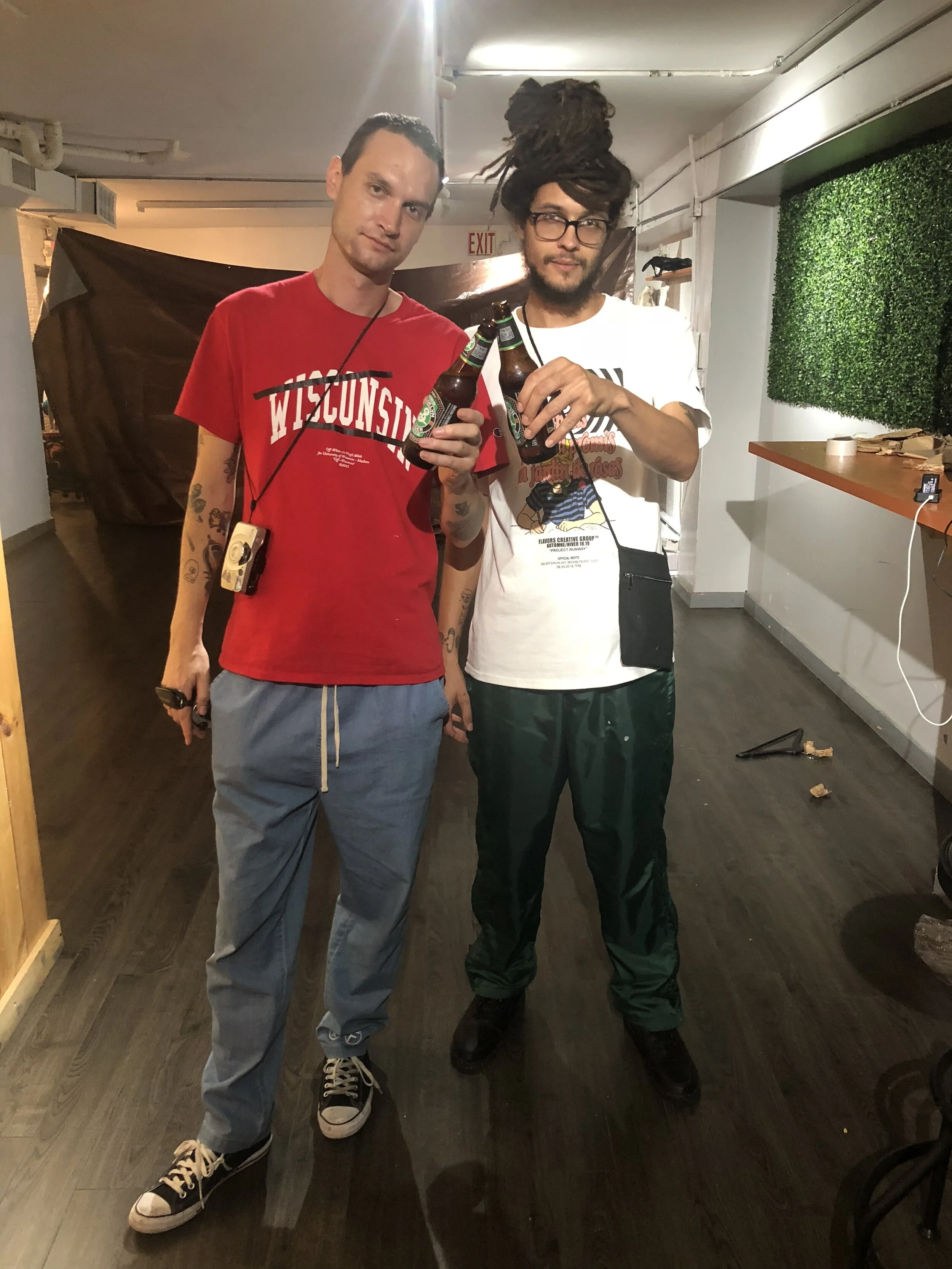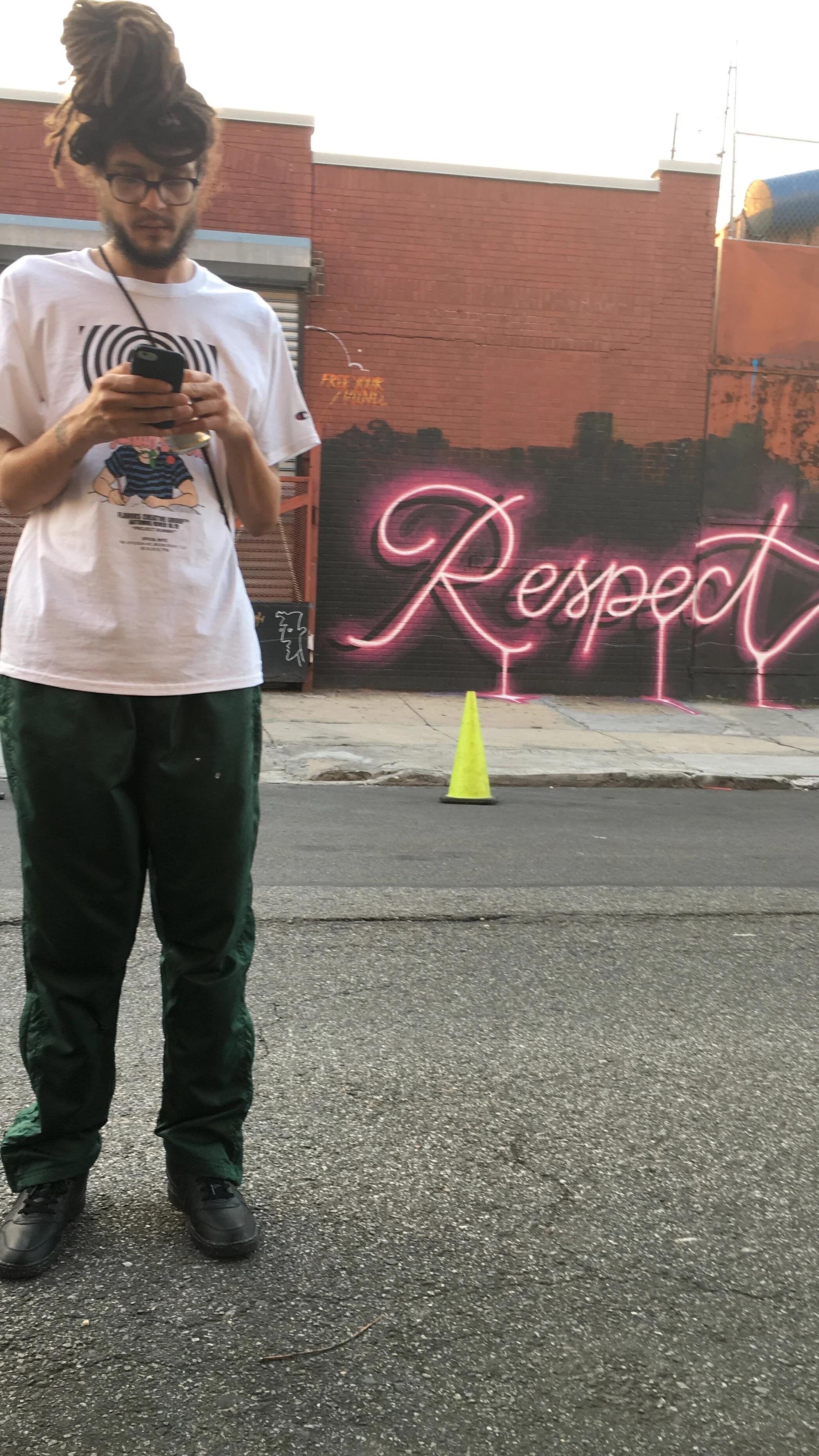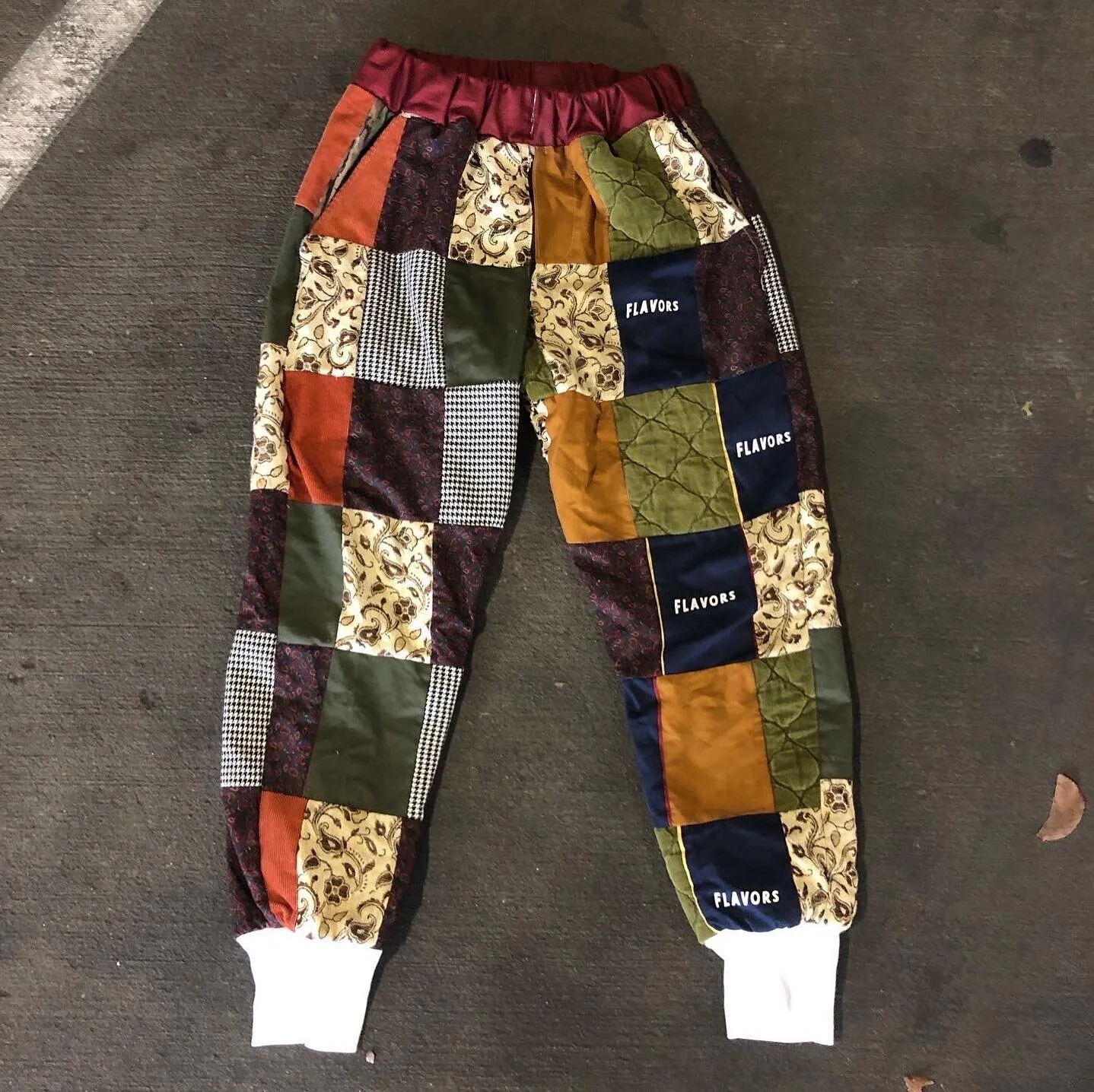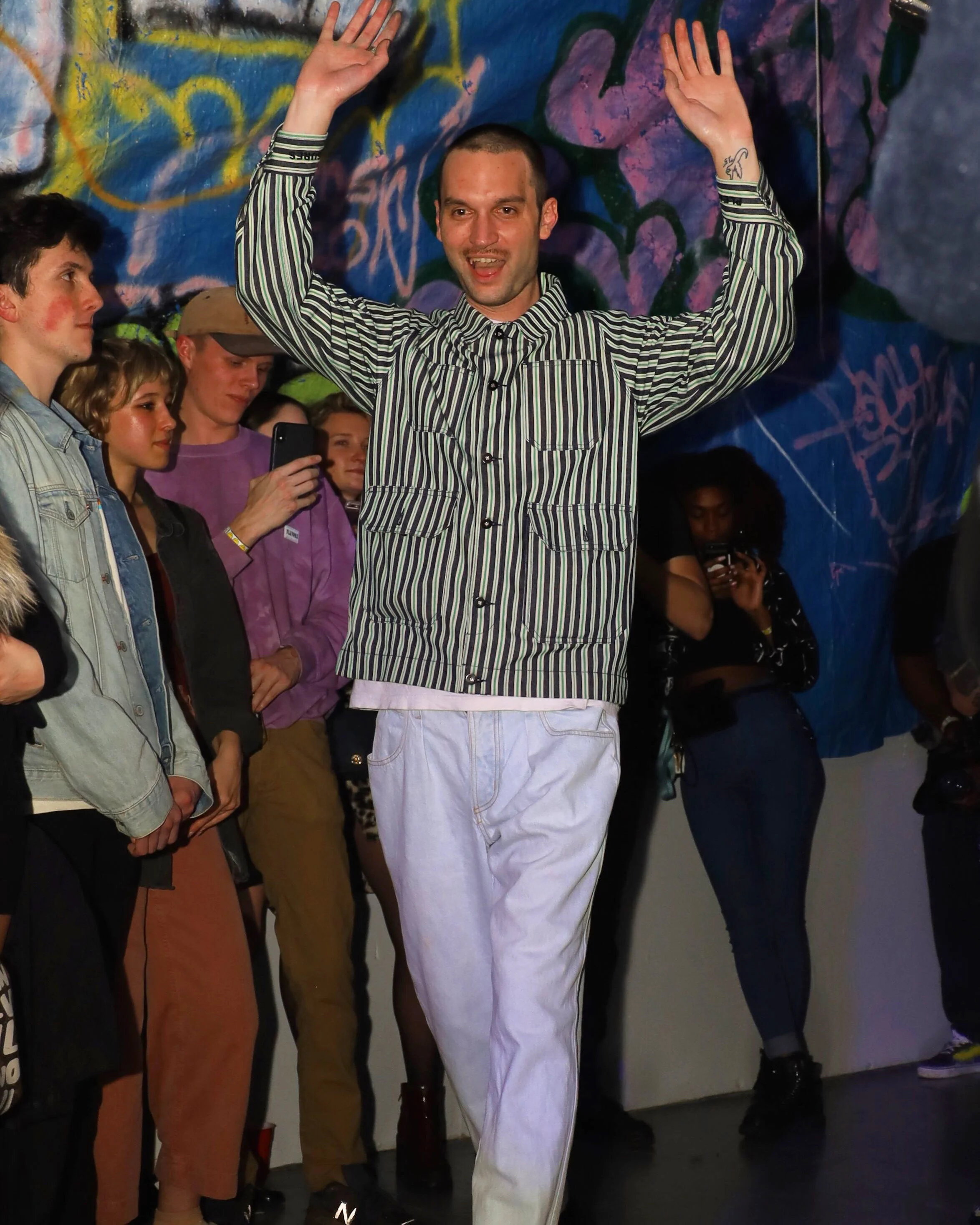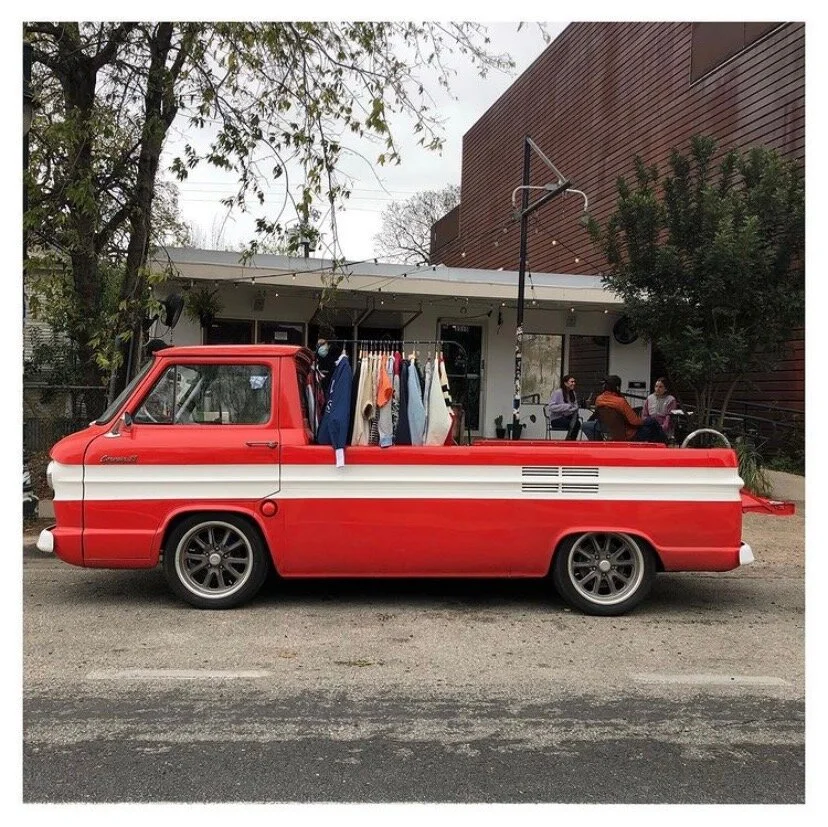
Flavors Creative Group
By Hayley Labrum Morrison
I worked with Flavors Creative Group on a collaborative fashion collection that featured marbled T-shirts earlier this year. As I familiarized myself with the Flavors brand, I found their creative and sustainable approach to streetwear to be refreshing and genuine. Based in Austin, TX, Taylor Henderson, Creative Director and Owner, and Eric Barnes, Head Tailor, have been showcasing the best of what a collaborative duo can accomplish since 2017. They hustle, they strive, and they make really cool clothes. Read on to see what drives Flavors to keep moving onward and upward in the challenging world of fashion.
Hayley: How did the two of you meet?
Eric: At the mall.
Taylor: Yeah, we both worked at different retailers. He worked at Zumiez and I worked at the Vans store.
Eric: You (Taylor) came in the store to say “What’s up?” to my manager Matt Talley and he was like “Here’s my friend Taylor”, and “Here’s my friend Eric”, and we just started skating and partying.
Hayley: And when did you start working together?
Taylor: When I started Flavors years ago I had some one-off concepts and I asked Eric and our friend Hunter to help out. Then about a year and-a-half into it we really started transitioning into it and the whole sustainable streetwear side of it came out. We kicked that into full-time and it gave us both a role in the company, rather than just random projects every once in a while. We were able to take the design to the next level from just screen printing T-shirts and hats to something more intriguing.
Taylor and Eric of Flavors Creative Group.
“The type of clothes you wore defined the type of skater you were.”
Hayley: So, you both skateboard. I feel like there’s this whole world of fashion there. No one wants to admit they’re trying, but they are definitely trying.
Eric: I think everyone within the skate world is well aware. Especially back in the day, the social media era, the type of clothes you wore defined the type of skater you were. Like if you were a hip-hop cat, or a punk rocker dude, or the reggae kind of guys.
Taylor: I know the tone that you mean. Dudes be acting like they didn’t put that outfit on to go skate. And it’s like, we know damn well that you wear a 32 inch waist and you're buying pants in a 36 inch waist. We know you are going for that style. Fashion’s a big part of it. Everyone jokes that it’s “Attitude, fashion, and wheels”. There’s a huge aesthetic with it. That was very much the case with me growing up. I started skating when I was eleven or twelve years old. You just see all these brands with fire graphics and fire shirts.
Eric: Back in the day you couldn’t be rockin’ all the brands. You had to like, find your lane.
Hayley: Like how everyone knows you can’t wear Nike and Adidas at the same time!
Eric: Precisely.
Taylor: It was even colder back then. Back then all the dudes we looked up to would hate on little kids. If you’re wearing a Vans shirts with DC shoes, you’re in a position to look whack. You can’t be doing that. It’s funny growing up in that culture because you’re so driven in how you dress. It was much more like, skateboarding leads to fashion.
Eric: Nowadays skateboarding is a fashion trend. It’s all packaged into one thing. But back then it was bigger than that. If you got into skateboarding you knew all the shit. You had to get the magazines, and the videos, and all the content. You absorbed all of it. It wasn’t oversaturated like it is now. People are wearing Thrasher shirts now. All the models are wearing Thrasher shirts. Back in the day, skaters didn’t wear Thrasher shirts. It was kind of hard to get one. I saw Skateboard Mag shirts before I saw Thrasher shirts (laughs).
Hayley: How has growing up with skate culture influenced the way you create clothes?
Taylor: Everything within the culture we grew up in is more diverse, that gives us a window to make unique stuff. I don’t know that skateboarding is my first demographic to sell to. I love it, but...
Eric:... but we treat skateboarding more as a big influence in our lives...
Taylor: Yeah, it doesn’t define who I am as a designer or a human. I skateboard and have fun with it, but I don’t really know what I’m doing, so it’s always been more of a hobby. But the influence that came with it and the way that I always wanted to dress, that turned into its own thing like “Okay, people are really responsive to creative stuff, no matter where that’s coming from”. So we expanded the demographics and marketed to unique individuals. We make stuff that really speaks to people. That brings us more joy than anything, especially me. I think it’s really cool to say we can take all this old stuff and make something really cool from it.
One-of-a-Kind Jacket by Flavors Creative Group, 2020.
Hayley: Talk about that more, the use of old material.
Taylor: Some brands consider only running pre-orders, or only running 100% cotton US-based and -sourced shirts as a means to sustainability. To me that’s not necessarily the case, because when we are able to do as much as we can with older garments, that’s a more sustainable approach. Every aspect we look at is definitely conscious. We do some collections, like the sweatsuits, that might contain polyester or synthetic fibers, but we take a conscious approach and try to do pre-orders that limit the amount made. Then on the other side, is us literally sourcing second-hand fabric: people donating garments or us going out and sourcing specific garments for pieces.
Hayley: Does that take a lot of time?
Taylor: During the quarantine we were doing face masks. So a lot of the fabric was donated and dropped off to us, and we’d sanitize them and use them. So we weren’t sourcing the fabric. That got really cool that people were like “Oh y’all are taking fabric, you’re taking garments, I have some, do you want it?” And so we kinda got to pick through them and that alleviated a lot of the energy of having to source fabric. Another aspect that comes from donations is, it’s just a brand new idea for us, like “How can we incorporate this into what we are doing right now. How can we utilize this?” And then we take action. That’s why a lot of the stuff we do has sporadic sizes and can be one-off.
Flavors Face Masks, 2020.
“We both just have the willingness to learn. I’m eager.”
Hayley: Eric, did you teach yourself how to sew?
Eric: I did, yeah. I took a little four-hour class. Everything else was online. YouTube University, as we call it.
Taylor: Both of us learned everything through YouTube. I never went to design school or any of that. We both just have the willingness to learn. I’m eager.
Hayley: It goes to show, you can learn anything you want, especially with the internet, as long as you have the desire.
Taylor: Sometimes it’s more valuable too, since you actually retain the information because you want to.
Eric: It goes right back to the influence of skateboarding. You had to learn all them tricks yourself, especially back in the day, nobody’s gonna sit there and teach you. Nowadays you can go on YouTube or everybody’s cool at the park, but with toxic masculinity back in the early 2000s, no one’s gonna teach you anything. So you sit there in front of your house for hours trying tricks and you develop that mindset of “Man, I can teach myself anything.”
Taylor: Yeah I remember when I was younger I went to this skatepark and I had never skated before and I needed to put my board together. They had a little shop there and I asked the dude if he could help me set my board up and he was like “No, you need to do it yourself.” That’s great, I learned from it, but I thought to myself, “I never want to be like that.”
Hayley: Was there an attitude of “I had to teach myself how to do it, so you do too”?
Taylor: Yeah I think that’s always there, whether it’s toxic masculinity or the aggressiveness of skateboarding. It’s just wild to think that’s how it used to be, and now it’s much more open.
Eric: Tough love used to be the thing, in general. Parenting, friendships, in the 80s and 90s, that was the thing. That’s what I came from.
Eric of Flavors Creative Group.
Hayley: What’s the process of creating a garment?
Taylor: Usually I come up with the concepts and Eric makes them into life. Either someone will donate a garment or I’ll source a garment. I’ll look at everything we have total and I’ll say “Okay this would be really cool with this,” and so on. And now we are starting to develop lineups based around that. So we have collections that we do like a full size-run of sweaters that are completely different but they have the same theme to them. For example, maybe there are added pockets to the front and a hood on the back. Or the sleeves are all cut in different colors. It all starts with looking at it, visualizing, and saying, “Okay these go together.” And then from there it’s like “Okay can we do this? Is this possible? What materials do we need? What embellishments? What branding?” And then we’ll sit together and draw it up and then basically Eric will cut the patterns and we’ll piece it all together.
Eric: Basically, the way it gets handed off is that Taylor will tell me the whole idea and I’ll give my two cents. Then he’ll finalize the idea and give it to me. But before that we talk it through and look at the fabric together and make sure we have enough.
Taylor: And another thing too that’s a huge part of what we do, now especially, is “Is this worth our time?” and we’ll look at how long it will take. So maybe it will take three to four hours, “okay perfect”, then it’s worth the pay rate to contract Eric out to do that. Because I want everything we do to be worth our time. Especially as a small company, there are no more handouts. I used to do that, like, “Might as well,” (shrugs) but not anymore, don’t have time for that anymore.
Eric: After that I just put it together, come up with a little plan. I’ll figure out what needs to be cover-stitched or serged and what not, what colors we need.
Taylor: We just upgraded all of our machines last year, too. So we’ve got really good stuff. The cover stitching and the serging go hand-in-hand with the lifespan of a garment. That’s what really separates a well-made garment from something that was hand-sewn quickly or that would need to be altered or patched often.
Eric: Yeah, yeah, when you have raw edges just hanging out and you don’t have anything tying them together, the fabric is eventually just going to come apart. The stitch line is not going to hold that together. You just got to take them time to serge everything. It can take up to an hour to serge an entire outfit, but once you do, it will stay together for a long time, like a really long time. Taylor will tell me where he wants all the branding to be, where all the tags need to go, this and that. Then he takes it over, takes pictures of it, edits them, puts them on the website, on the Instagram.
“No matter where I go, I’m always representing.”
Taylor: And the studio that this lady Tonya has, that’s what we use for our embroidery and our screenprinting studio. So up North in Georgetown there’s a whole other section we get all of our work done in. I’m up there three or four times a week.
Eric: Yeah and we have to drive up to Georgetown, drop it off, go pick it up, etc.
Taylor: I do all the graphic designing, marketing, website, most of the photo shoots and look books. Both Eric and I do the pop-ups and handle events.
Eric: No matter where I go, I’m always representing. If I see a business opportunity that Taylor might be interested in, I try to get their contact and hit ‘em up and see if something can work out.
Taylor: He’s got an eye for networking with other shops. I look out for the BREWERIES.
Eric: (Laughs) I was gonna say you do the breweries. First they are talking about Flavors and then the next thing you know they are making us a beer. We both network a lot, but it goes back to our days working in retail.
Taylor: Not only that, we believe in it. It’s tight. If you’re going to make my ass sell Volcom, I can damn well sell Flavors.
Eric: I learned all that working at the mall and applied it to Flavors. You never know who you are talking to. You might think that someone’s not interested because you make an assumption and next thing you know they got a whole other opportunity for you. Not to boast, but last week Shakey Graves was at the pop up.
Taylor: And Lamorne Morris, Winston from “New Girl” wore our clothes in Away magazine. That was a huge encouragement.
Lamorne Morris Wearing Flavors Creative Group x Damn Glam in Away Magazine, 2020.
Hayley: Do you have any favorite projects you’ve worked on?
Eric: The biggest accomplishment for me was making the patchwork pants 'cause I had to put all of that together myself and figure out how many rectangles I would need of each fabric, and do all the planning, and all the adjustments, and I think it was the first time I made something that was lined the way it was. That was my biggest accomplishment.
Taylor: I like a lot of the stuff we’ve been doing. I’m super into tie-dying. I love tie-dying, it’s fun. Jessica at Dylan Wylde opened up my mind to that. I’m really impatient, so it’s an immediate response. I also had a lot of fun working on the masks with Eric. That was cool. We had a good workflow for that. It was kind of fun for me, I really enjoyed that time. Just wake up, and we are either gonna make this money or we’re not. We didn’t have anything else to do.
Patchwork Pants, 2019.
“We’re a retail business, this is our whole… everything.”
Hayley: Around that time we were working on a project together that came screeching to a halt when the pandemic hit. You were planning a fashion show and pop-up shops, and you were gonna do SXSW and you had all of these ideas. How have you worked through all of that?
Taylor: We had a fashion show planned. We had curated our own show finally. I was so excited for that. Three weeks later we called it, and then we were like “We have to make money somehow,” but we didn’t want to just sell random stuff to people as though nothing had happened.
Eric: We did two months of masks—
Taylor: —Three—
Eric: —Three months of masks. And then when everything started to cool down and became appropriate again for business, that’s when we started to sell again.
Taylor: That’s what I was gonna say, I felt weird releasing new things, so I released all the hoodies. I did a run of like three different hoodies to, you know, keep people cozy, see what the response would be like, like “Is it safe to sell again? Does it seem disrespectful?” Things like that. Then after a huge response from that we thought “Well we do have to make a living, we’re a retail business, this is our whole… everything.” So I just ran with that and I did a release about two weeks later. Since then we have released once or twice a month over the past four months.
Eric: We had a lot of stuff in the studio though that was hanging in there. So we were able to just like jump back in and combine stuff together.
Taylor of Flavors Creative Group.
Hayley: You're getting the momentum going again! How did your pop-up go the other day?
Eric: It went really well.
Taylor: Yeah it was great. We’re really grateful to Try Hard Coffee for letting us come out. The manager, Rachel, had this really cool red truck and let us borrow it and do the pop up in there. We kept everyone socially distanced and two or three people would go up in it at a time and shop on the truck. It was really cool. Just being out on East Eleventh...it was a Sunday, nice weather.
Hayley: It seems like things like this could be the new normal for a while.
Eric: I think we’ve been pretty lucky that the pop-ups that we’ve had are with places that are very conscious of and worried about people’s safety. We haven’t been doing them at places that are overcrowded, ‘cause there is a lot of that going on. Like with Try Hard having a limited amount of stuff—we don’t have overhead like that. So when we sell five or six items, we’re happy. We do that two or three times a month, we can move out a good amount of inventory and we’re ready to make some more. We’re kind of smart with the way we keep our overhead small. And everything is fire, so when people see it in person they want it.
Try Hard Coffee x Flavors Pop-Up Shop, 2020.
Hayley: So how do you toe that line between artistry/creativity and commercialism?
Eric: It goes back to the core of Flavors’ principle of selling something that we really believe in. We aren’t out here pushing something for someone else or that we don’t believe in. We do need to make money, obviously, but it’s rooted back into making something sustainable, man, we’re trying to make a change, we’re trying to make our mark and show people that you can be inclusive.
Taylor: At the end of the day we are a streetwear company. So the hats and the shirts and the captivating graphics also play into what we do. And statement pieces aren’t always what people want. I’m not the type of guy that wears statement pieces, but I love designing them, I love making them, that’s my core. But that’s for a specific crowd. There are other people that just love our brand and what we stand for and they just want a shirt with our name on it. So as a streetwear company I’m not going to take away that aspect, but rather I’ll be more conscious about where I’m coming from with sustainability and branding.
“I’m being patient more so than ever right now, and it’s working for us.”
Hayley: So are you gonna keep it pretty in-touch and streetwear oriented?
Taylor: Yeah I’m just gonna keep going with what we are doing.
Eric: Yeah we never want to sell a $600 T-shirt.
Taylor: Our jackets might go up—
Eric: Yeah yeah. Our jackets might!
Taylor: They might go up considerably. Con-sid-er-ably.
Eric: But a screen-printed T-shirt? Never.
Taylor: We just can’t. You’re paying for the name behind that, you’re literally paying for the brand. I understand that, as it holds value in the market. That doesn’t work for smaller brands with no influence. I’m not in the realm of New York fashion week trying to compete with everybody. We’re in our lane, we’re moving progressively forward, I’m being patient more so than ever right now, and it’s working for us. This is more than I expected.
Eric: Yeah absolutely. We’re not trying to be involved in the whole classist thing, we’re just looking for fairness. All we want to do is get paid for what we make. Not anything extra, or anything less.
Taylor: But that’s just it, saying that we don’t want to seem pretentious or ego-centric because of the price of our garments. But people need to realize that because we don’t have that influence and that huge brand, that our pieces are affordable. The pieces that we make would retail at three times the amount by a big-name designer.
Hayley: So when people are like “$100 for this jacket? They should be like “Wow, $100 for this jacket?”
Taylor: We always want to be an inclusive brand, especially with our name. So it’s like, we’ll always be able to have that pricepoint for a T-shirt or a hat. And then there may be some pieces you can’t afford, but there’s always something there for everyone.
There are people still to this day, after how long we’ve been doing this, that don’t even realize that these clothes are home-made, that we are making these. If they’re not realizing how much work that we are putting into the aesthetic, by ourselves, and then if we bring in someone else (a collaboration with another creative) into the mix and they are getting money from it, it’s a lot to bring into the public eye, so I need to dial it back and really get people in tune with what we are doing and how we are trying to make a difference in the streetwear world, and go from there.
12/17/2020
Follow Flavors Creative Group on Instagram and check out their online shop for current items for sale.


